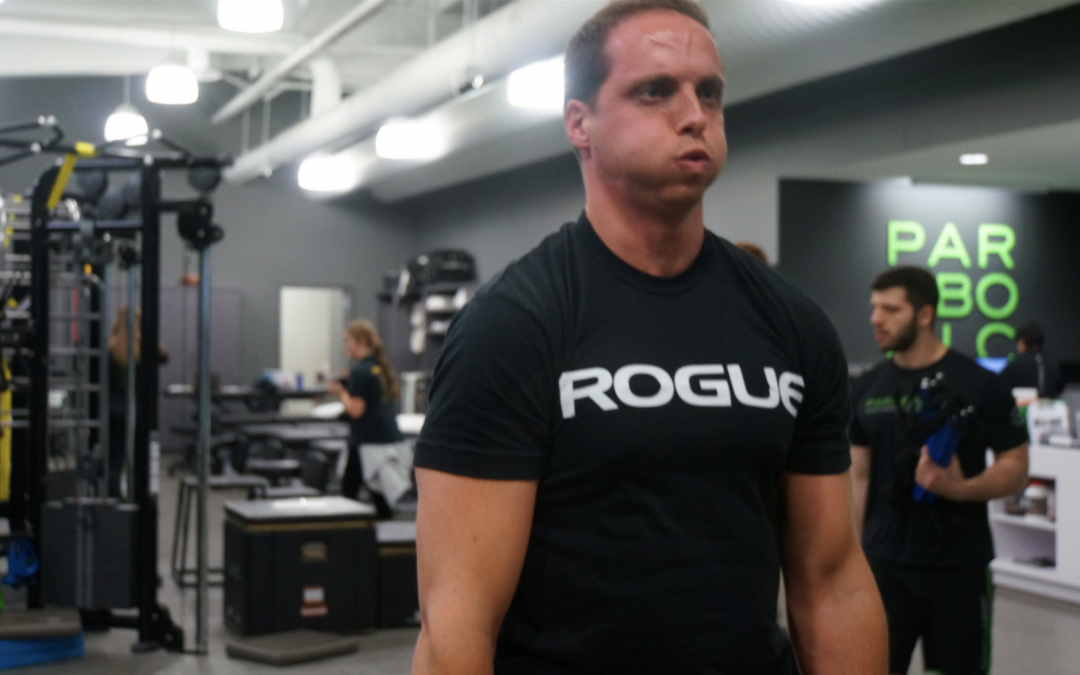Here at Parabolic, we talk a lot about how we use positional breathing drills to influence mobility and stability. We even talk about how viewing movement through a PRI lens has influenced how we coach and program exercises for our athletes. Justin Moore has written several great articles on how PRI drives our program design and exercise selection. However, one thing we have not discussed is how to actually breathe during your workout to get the most benefit from those things. The perfect positional breathing resets will do nothing for you if you are not using the right breathing strategy to stabilize your body while you lift. There are two main breathing strategies that can be used to gain stability during movement. They are breathing and bracing.
First, some definitions as they are relevant to this discussion:
Breathing: Mostly focusing on a long and relaxing exhale and proper inhale to use breathing to set the position of our ribcage and pelvis. This is a lower threshold activity,
Bracing: A forceful holding of breath that uses a higher threshold strategy to stabilize the thorax and pelvis. This is often the Valsalva maneuver.
The important thing to consider here is that there is no right or wrong strategy. There are only appropriate ones for the task at hand. If all you can do are high threshold strategies, then that is a problem. If you can never brace properly and create an appropriate high threshold stabilization strategy, you are probably not going to be petty strong. But you better be able to shut that strategy down after the lift is completed. You also want to make sure you are doing this correctly.
So now the question is, when do we want to use each strategy? And how do we most effectively perform each one to get the appropriate amount of stability?
Breathing
We want to be casually breathing to stabilize our spine during any activities that are not true high intensity efforts. This starts at positional breathing drills and goes all the way up through core activities, assistance work, and also lighter squatting and deadlifting for most clients.
We want to breathe properly to stabilize our spine and thorax by putting our major joints in proper positions. This usually requires a full exhale to get rib internal rotation and posterior pelvic tilt. This puts our abdominals and true hip extensors in a position to work properly to stabilize and propel movement. Here we are not holding our breath at all. We can think of inhalation as a position of extension of the entire system. An inhalation is also a sympathetic event. On the contrary, exhalation creates flexion and a parasympathetic tone.
If we always create a forceful inhale and hold when we lift, we will probably present with much more extensor tone than necessary. In addition, we might never be able to shut off the sympathetic tone. Our blood pressure will be much higher, and we will tire our much easier. Therefore, it will be much more effective to stabilize ourselves with a lower threshold breathing strategy that allows for a long full exhale.
Bracing
However, there are times where we really need to brace and hold a powerful inhale to stabilize ourselves. Usually, this will happen under really heavy loads for higher-level athletes. When we brace, we can create a large amount of air pressure to keep us stable, but this comes with a cost. This is a strategy that only needs to be used for higher level athletes under heavier loads, but for these circumstances, it is a must. I am a believer that no-one needs to be cued to brace. They should be shown how to do it properly, and after that, it should be reflexive. If the proper steps are not taken through a proper exhale and an inhale from an exhaled position, no amount of cueing brace help them brace.
How to Correctly Perform Each One
Breathing
Breathing during lifting activities that do not require a brace is very similar to how we breathe during our positional resets. Most people present with an extension pattern, so the most important thing is usually to get a long full exhale to internally rotate the ribs. This is especially important any time the arms or legs are moving away from the periphery. As a general rule of thumb, I tell my clients and athletes to get a long and full exhale any time their arms move overhead or their legs move away from them. I only allow them to go through a range of motion that they can exhale through. For example, I have them exhale as their arms go overhead in a kettlebell pullover. As soon as they stop exhaling and start holding their breath, I know they have gone too far and I instruct them to cut the range of motion a little shorter.
After the full exhale, there are certain times where we require an inhale to expand a posterior mediastinum.This opens up the upper back and allows the scapula to have a congruent surface to sit on. We do this by asking for an inhale that expands the upper back and ribcage but it is important that this inhale is coming from a fully exhaled position.
We need a long full exhale to set our ribs down, and then when we inhale we must do it from that position of full exhalation and rib internal rotation. If we inhale from a position of inhalation, we will only end up extending our spine further which will put us in in a suboptimal position to create true active stability from. Instead we will rely on passive stability from bony and ligamentous structures, which is not what we want to be doing.
Bracing
When we do brace, we hold a forceful inhale which as we already discussed is a sympathetic event and drives some amount of extension. However, there is a right and a wrong way to go about this. As we also mentioned, an inhale must come from a position of full exhalation if we want to truly stabilize our thorax. If we inhale from an already inhaled position as most of us do, we actually just end up jacking ourselves further into extension. Inhalation is a position of extension, and if we inhale from extension we will have a whole lot of extension. If we do this, we will present with much more extensor tone during lifting, we will not truly have intra-abdominal and intra-thoracic pressure, and we will probably jack ourselves up long term.
So when lifting requires a brace using the Valsalva maneuver, we MUST first get a long and FULL exhale with rib internal rotation and some degree of posterior pelvic tilt. After that exhale, we should pause for a second or two and then inhale. But here is the kicker; when we inhale we must keep our abs on to eccentrically internally rotate our ribs. In other words, they have to prevent our ribs from flying up when we inhale. If that happens, we just extend our back and will not have the abdominals and hip extensors in proper positions to stabilize our thorax and extend our hip. The air can go to two places when we inhale, and the position that we start from is the determining factor. It can go in the front of our ribcage as we extend our back, or we can keep the ribs down and have it go in the back of our upper back. We want the latter to drive stability by using air pressure and correct biomechanics instead of relying on extensor tone and passive constraints to stabilize ourselves.
Conclusion
We are going to get sympathetic extensor tone when we lift. That is a given, but we can stabilize ourselves in a way that will not create any unneeded tone. This is done by using the appropriate AND correct breathing strategy for the task at hand. We shouldn’t be bracing when we don’t need to be. On most exercises, we should use a relaxed breathing strategy utilizing a full exhale to maintain the proper position of our joints which will in turn place the correct muscles in position to propel the movement and stabilize. We shouldn’t be using a high threshold bracing strategy on low lever exercises like rolling, dead bugs, planks, and even non-maximal strength training like goblet squats and trx rows. However, there are times when we do need to brace. When we do, we must do so properly to most effectively stabilize our thorax and not place ourselves in more extension and sympathetic tone than which is necessary.
Shown below are specific exercises with a good inhalation after a state exhalation before beginning the exercise itself…And then there’s the bad. You will also see exercises with inhalation from a state of inhalation and how little you will get out of the exercise.

